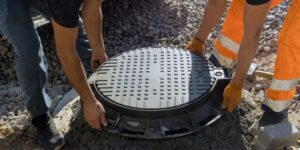Introduction
In the quest for more sustainable and energy-efficient building solutions, the energy-recovery wheel stands out as a pivotal innovation in HVAC (Heating, Ventilation, and Air Conditioning) systems. This technology, also known as a heat recovery wheel, plays a crucial role in reducing energy consumption and improving indoor air quality, making it an essential component of modern green building designs. This article delves into the operational principles of an energy-recovery wheel, its benefits, and how it enhances system efficiency, providing a comprehensive understanding for stakeholders in the building and energy sectors.
What is an Energy-Recovery Wheel?
An energy-recovery wheel is a device integrated into HVAC systems to facilitate the exchange of energy between incoming and outgoing air streams. It consists of a rotating cylinder filled with a material that absorbs and releases heat and moisture. As the wheel rotates, it captures heat and moisture from the exhaust air and transfers it to the incoming fresh air, thereby pre-conditioning the air before it enters the building space.
Operational Principles
The energy-recovery wheel operates on the principles of thermal and moisture transfer. The wheel’s rotation, typically powered by a small motor, allows for continuous exchange of heat and moisture between the two air streams. The side of the wheel exposed to the outgoing air absorbs heat and moisture, which is then released into the incoming air as the wheel rotates. This process utilizes the thermal energy from the exhaust air, which would otherwise be wasted, to pre-condition the incoming air, significantly reducing the demand on the HVAC system for heating or cooling.
Benefits of Energy-Recovery Wheels
Enhanced Energy Efficiency
By reclaiming waste heat and moisture from the exhaust air, energy-recovery wheels significantly reduce the energy required to heat or cool the incoming fresh air. This can lead to substantial energy savings, particularly in climates with extreme temperatures, where HVAC systems are heavily relied upon for maintaining indoor comfort.
Improved Indoor Air Quality
Energy-recovery wheels facilitate the introduction of fresh outdoor air into the building while minimizing energy loss. This continuous exchange of air helps to dilute indoor pollutants and maintain healthy indoor air quality, which is vital for occupant health and productivity.
Cost Savings
The reduction in energy consumption translates into significant cost savings on utility bills. Additionally, the decreased load on HVAC systems can extend their lifespan and reduce maintenance costs, further enhancing the financial benefits of energy-recovery wheels.
Sustainability
By optimizing energy use and reducing reliance on fossil fuels, energy-recovery wheels contribute to more sustainable building practices. This aligns with global efforts to reduce carbon emissions and combat climate change, making it an appealing solution for eco-conscious stakeholders.
How Energy-Recovery Wheels Improve System Efficiency
Energy-recovery wheels improve system efficiency through several mechanisms:
Reduction in HVAC Load
By pre-conditioning the incoming air, the energy-recovery wheel reduces the workload on the HVAC system’s heating and cooling components. This not only lowers energy consumption but also prevents system overuse, contributing to more efficient operation and longer system life.
Optimal Humidity Control
The transfer of moisture along with heat helps maintain optimal indoor humidity levels. This is particularly beneficial in humid or dry climates, where maintaining comfortable indoor humidity can be challenging and energy-intensive.
Versatility in Various Climates
Energy-recovery wheels are effective in both hot and cold climates, making them a versatile solution for improving energy efficiency across diverse geographic locations. In winter, they capture heat from the exhaust air to warm the incoming cold air, while in summer, they can remove excess heat and moisture from the incoming air, reducing the cooling load.
Integration with Renewable Energy Sources
Energy-recovery wheels can be seamlessly integrated with HVAC systems that utilize renewable energy sources, such as solar or geothermal energy, further enhancing the overall efficiency and sustainability of the building‘s energy systems.
Conclusion
The energy-recovery wheel represents a significant advancement in HVAC technology, offering a practical solution to improve system efficiency, reduce energy consumption, and promote sustainable building practices. Its ability to recover waste energy and optimize indoor air quality makes it an invaluable component of modern HVAC systems, aligning with global efforts towards energy efficiency and environmental sustainability. As the focus on green building design continues to grow, the adoption of energy-recovery wheels is poised to play a pivotal role in shaping the future of energy-efficient building solutions.





